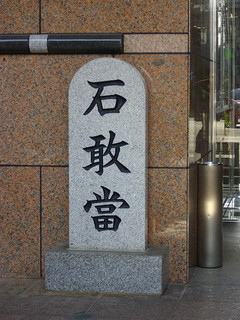Ishiganto
From SamuraiWiki
Jump to navigationJump to search
One of many ishigantô in Naha.
- Other Names: 石敢當 (sekkantou), 石散當 (sekisantou)
- Japanese: 石敢當 (ishigantou)
Ishigantô are stones erected at intersections and inscribed with the characters 「石・敢・當」 (ishi, gan, tô)[1] as a charm against evil spirits. The practice started in China, and spread to Japan via Ryûkyû; today, ishigantô can be found as far north as Aomori prefecture, though they are by far the most numerous in Okinawa and Kagoshima prefectures.
Some accounts relate that the earliest ishigantô was erected by a governor of a district within Fujian province in the year 770, but the true origins of the practice are unclear.
References
- "Ishigantô." Sekai daihyakka jiten 世界大百科事典. Hitachi Solutions, 2012.
- ↑ Or, occasionally, variations such as 石敢堂, 石当散, 石散当 or 石将軍, the latter being especially common in Fukushima prefecture, and in China.